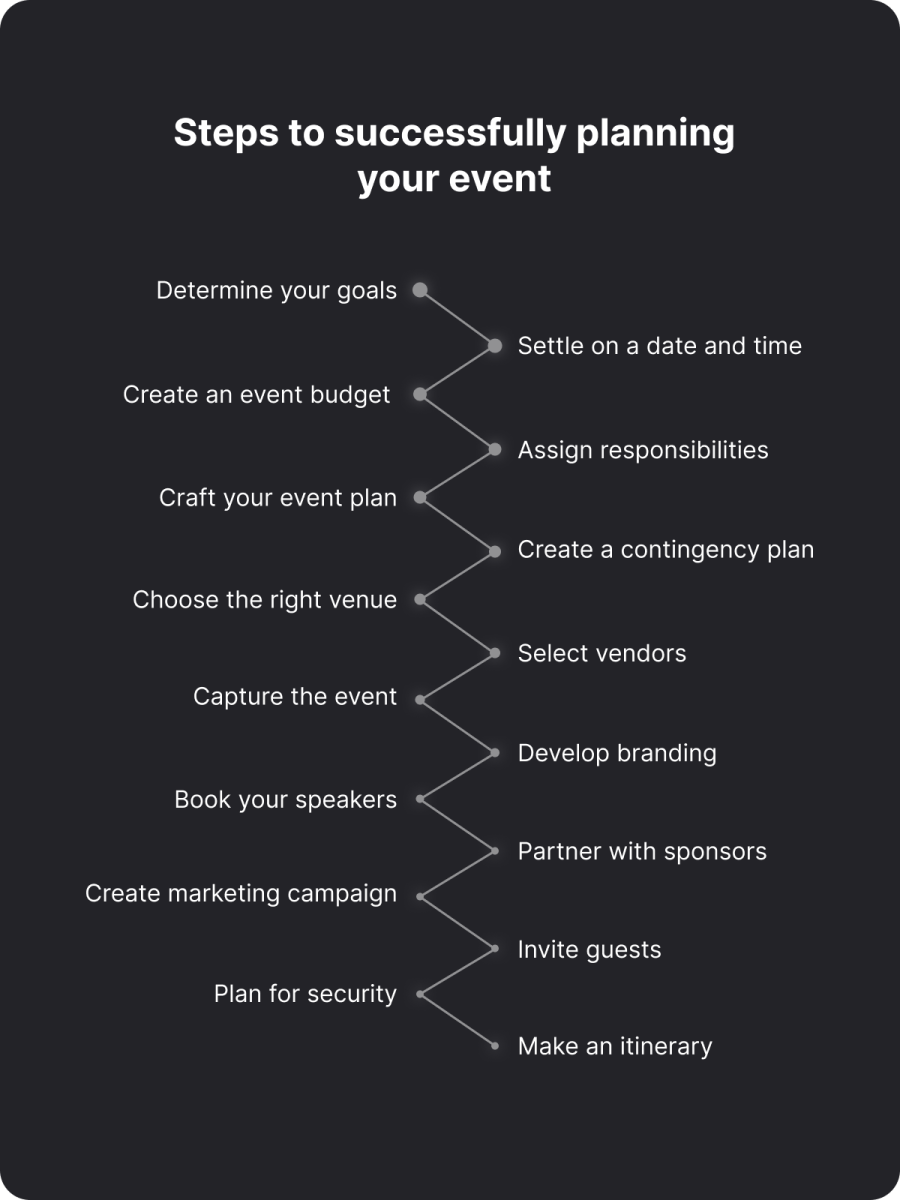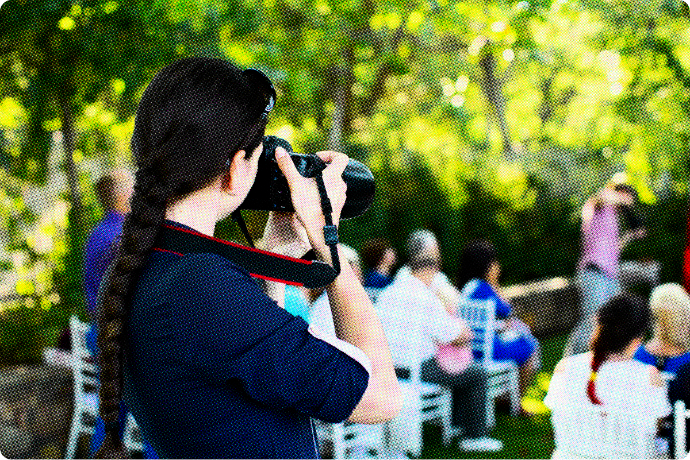How to Plan an Event: Your Complete Guide
Event planning comes in many different forms with many objectives and goals. While the pandemic slowed down in-person events, it opened up a new era of event planning.
Organizing events is still a thriving part of marketing departments since 9.4% of the CMO marketing budget goes to (live) events.
Planning a celebration or conference for your company entails more than just throwing a dinner or party. But no stress, we got you covered. This event planning guide will provide much-needed support.
In this blog, we’ll guide you through the most important steps and details in planning your next successful - and profitable event.
What is an event plan?
Behind every event, big or small, is a plan of action and a dedicated team that made it happen. The framework is set up and safely guarded by an event manager.
Your event plan is a comprehensive document that outlines all the essential details and information, including the event’s purpose, objectives, target audience, date, time, location, budget, vendors, schedule, program, and logistics.
An event plan typically includes the following sections:
- Introduction: A brief overview of the event, its purpose, and objectives.
- Event details: The date, time, and location of the event, as well as any relevant background information.
- Budget: A detailed breakdown of the event budget, including all expenses and income sources.
- Marketing: Strategies to promote the event and reach the target audience, internal or external.
- Program: An outline of the event program, including speakers, activities, and other elements.
- Logistics: Details on equipment, staffing, location, and other logistical details.
- Risk Management: Contingency plans in case of emergencies or unexpected situations.
- Evaluation: Methods for evaluating the success and identifying areas for improvement. This step could create a blueprint for your next gathering.
When approaching a project from zero, a practical event planning checklist will be your best friend. These plans can be simple or complex, but the goal is to help you to keep track of what needs to happen so your entire event plays out exactly as imagined.
16 steps to successfully planning your event
Since events are temporary and have a set beginning and end, event planning sets up the structure and guidelines. All the work involved is very hands-on, and event managers might have to deal with high expectations, a tight budget, and vendors.
Successful event planning knows different lifecycle stages. Use the following steps as a guideline and break your event plan into achievable milestones.

1. Determine your goals
The first step in any planning process should be outlining your event goals.
Are you trying to attract new clients, show employee appreciation, or provide professional development opportunities?
Having a goal-setting mindset is invaluable for event planners. Without a framework, how can your team know if they’ve met or exceeded expectations? Plus, higher management would like to see a return on investment.
Make sure you keep your end goal in mind as you go through the rest of the planning process. A solid idea of what you're trying to accomplish can do wonders for creating a thorough, effective plan.
2. Settle on a date and time
Decide what day and time you'll host the event. For something as simple as a work party, you'll just need to find a date and time that works for most guests. For larger events, you'll need to consider venue waitlists, speaker availability, and guest/event schedule.
3. Create an event budget
This can be a straightforward task with simple gatherings but gets notably more complicated for bigger conferences and occasions.
Allocate a percentage of your funds for each item in advance instead of pulling from one pooled account. This will ensure you don't accidentally spend large portions of your budget on unneeded items and keeps you from exceeding your event budget.
Consider a project management solution to keep track of your event budget, so you never have to worry about going over.
Not sure where to start with all the numbers? You can try two ways of estimating your event budget; top-down or bottom-up budgeting.
- Top-down budgeting. In this case, you already have a total amount for the complete project agreed upon by the client or your department. Break it down into tasks and activities with accompanying costs.
- Bottom-up budgeting. Once you’ve broken down the event and determined the cost for each phase, task, and activity, add it and conclude the total project budget.
Related: How to Create an Effective Project Budget
4. Assign responsibilities
The third step defines tasks and assigns the work to team members with a suitable skill set. Capacity planning goes beyond checking who’s available. Build your team and assess their strengths and weaknesses for the best result.
Get your team on the same page by providing a structured approach and keep the focus on the horizon: the date of the big event.
An event timeline will help you manage tasks and responsibilities. This visualization will show the event deliverables and activities. This format allows sharing with stakeholders, vendors, higher management, or your client.
Include the following information:
- All the tasks plus deadlines
- Estimated duration
- Dependencies
- Team members assigned to each task
Using a software tool like Rodeo Drive will make event planning a lot easier. For example, Rodeo Drive’s planning feature allows you to manage team capacity and assign tasks based on availability.
Plus, while planning tasks and setting up deadlines in Rodeo Drive, you will discover that project tasks correlate to a budgeted activity, helping you to manage productivity and event budget in one.
Schedule a demo of Rodeo Drive to learn more about how event/project management software can help you stay on top of your planning from start to finish.
5. Craft your event plan
The beating heart of your event is the actual event plan. Now that you have your budget and team sorted, it’s time to put all the details together in one place.
Your plan should be an all-encompassing guide with your tasks, team members, event schedule, budget, and any helpful contacts included.
This will be your go-to source of information throughout the planning and execution of your event.
Straightforwardly collaborate with your team and add a legend to explain abbreviations or language used in your industry. Ask and apply the team’s input and upgrade your event plan if it helps drive the team forward with the event goal.
Related: 12 Free Helpful Event Planning Templates
6. Create a contingency plan
It’s a life lesson: always expect the unexpected. This also applies to event planning. Setting up a contingency plan ensures that unexpected situations or emergencies are handled promptly and effectively.
Identify potential risks that may arise during your event. These include medical emergencies, power outages, or bad weather if you’re planning an outdoor event. Consider the specific factors that may affect your event, such as the location, time of year, and expected attendance.
Then, develop response strategies for each identified risk. This can include specific actions to take in the event of an emergency, such as evacuation procedures, medical response protocols, and communication plans.
Assign specific roles and responsibilities to key staff members, volunteers, and vendors. This will ensure that everyone knows what to do in an emergency.
7. Choose the right venue
For an office party or training workshop, you may be able to simply book a conference or break room at your office.
Larger event planning will require you to make reservations with venues such as event spaces, restaurants, or convention centers.
Popular venues often have long wait lists, so determine your location and lock in your booking as soon as possible.
If you are interested in booking the event location for a specific event, provide details such as the date, time, estimated number of attendees, and any other relevant information.
After your initial communication, be sure to follow up with the event location to confirm any details or ask additional questions as needed. Keep a record of all communication to refer to later if needed.

8. Select vendors
Overall, selecting the right vendors for your event requires careful planning, research, and communication to ensure they meet your event needs and contribute to a successful event.
Start by identifying the products and services you need for your event. This could include catering, audio-visual equipment, decor, and transportation.
Look for vendors who specialize in the products or services you need. You can find vendors through online searches, referrals, industry associations, and trade shows. Look at reviews or check in with fellow event organizers to discuss the vendor’s reputation. You can also ask for references and check their portfolio to see their past work.
Contact the vendors and ask for detailed proposals that include their services, prices, and terms and conditions. Compare the quotes and evaluate the value they provide for the price. Try all your negotiation tactics and see if you can agree on a price that fits well in your event budget.
Hold regular meetings or short check-ins with your vendors before and during the event to ensure that everything runs smoothly. Provide them with clear instructions and feedback to help them deliver their services how you want them.
A project management tool will help you discover how these costs influence your overall event budget.
Keep track of the payment status, too. For example, you may have submitted the deposit, but you don’t want to forget to pay them the rest the day of. An event management tool can help you keep track of all these details.
9. Capture the event
Many companies want to preserve their event for promotional materials or educational videos.
If your company doesn't have the resources to do this yourself, you can hire outside professionals to ensure your event is recorded. If you're booking audio or visual pros to handle presentations or music, they'll often offer this as an additional service.
Think about live streaming your event to reach a bigger audience. This won’t be applicable if you are organizing an in-company event but if you are booking speakers or have other guests, this will be a good way to market your event. Plus, you can use the material to promote your next event.
You will need a specialized vendor to make this happen and to ensure it looks professional. Make sure to allocate some of your event budget toward this.

10. Develop branding
Unified branding can give your event a professional look that makes a big impression. You want your event to be memorable.
A catchy name, theme, or even custom logo is an important part of event planning that can help set your gathering apart and catch the eye of potential attendees.
The branding should reflect the tone and personality of the event and its intended audience. For example, an informal in-house event for new employees would have a different brand identity than a conference for external industry professionals.
Create guidelines for using the visual identity across all event materials, including websites, social media, print materials, and signage to keep the branding aligned from pre- to post-event.
Use social media, email marketing, and other promotional channels to build awareness of the event and its brand. Create content that aligns with the event's brand identity and appeals to the target audience.
Continuously monitor social media, website traffic, and attendance to assess the impact of the brand on event success and goals.
11. Book your speakers
If you're utilizing guest speakers outside your organization, you'll want to connect with them early during event planning.
Speakers will often require included travel and accommodations, so make sure you take that into account with plenty of time to reserve tickets and rooms.
If your event has speakers or hosts from your business, they should have been looped in when you assigned responsibilities and tasks throughout your organization. If not, speak with them now so they have plenty of time to create a great presentation and prepare themselves adequately.
12. Partner with sponsors
Official sponsorships or more casual partnerships are excellent ways to fund events and give you an added opportunity to connect with potential partners.
Reach out to local businesses or related companies who may be interested in partnering with you when you're event planning.
Often, B2B organizations in tangentially related fields will be eager to work together, giving them an excellent chance to advertise to their primary demographic. This a great opportunity for event marketing where others can find out about what you're working on.
13. Craft an event marketing campaign
For smaller event planning efforts within your company, you can often just send an email or make a company announcement.
However, any larger gatherings will often necessitate an event promotion to announce the event. An effective event marketing campaign is crucial to attracting and engaging potential attendees and sponsors.
Identify what makes your event different from others and what value it offers to attendees and build your unique event proposition.
Determine the marketing channels you will use to promote the event, such as email marketing, social media, paid advertising, and content marketing. The channels you’ll use should be popular with your target audience.
Partnering with industry influencers and sponsors will increase your reach.
Create content that aligns with your event's brand and unique selling proposition.
This could include blog posts, videos, social media posts, and email campaigns.
Measure the success of your event marketing campaign using metrics such as website traffic, social media engagement, and ticket sales. Refine your approach based on feedback and results.

14. Invite guests
Even with large, heavily advertised events; you will most likely have certain companies or individuals you'd like to invite personally.
Make a list of people you want to invite to your event. Include their names, email addresses, phone numbers, and other relevant contact information.
Send your invitations out at least two weeks before the event. This will give your guests enough time to RSVP and plan accordingly.
Reaching out early during event planning will give you a better idea of your attendance numbers and give guests plenty of time to plan around your event date. Don’t forget to follow up with your guests a few days before the event to see if they can still make it or have any additional questions.

15. Plan for security
Depending on the nature of your event, you may need to take security into account during event planning. This could be as simple as checking name badges and registration information at the door.
Heavily attended occasions or events in certain high-profile industries may need additional security measures. Hiring a private security firm can be a great way of ensuring your gathering is enjoyable and safe for all involved.
16. Make an itinerary
By creating an event itinerary or brief for the day, you’ll avoid confusion while running the event. Make sure to include the expected arrival time for guests, details on transportation, and registration.
If there are any opening remarks, include introductions and welcome speeches. You might even have to be a ghostwriter for the speakers.
For the staff working at the event, include the timing and location of breaks.
As you go through your event planning process, slowly compile an itinerary or timeline for the event itself. You'll want a clear schedule of what needs to be done as your event unfolds.
Make a version of this itinerary available to anyone working the event, so everyone is on the same page. Double check if all the contact information of staff is up to date before getting started.
You should also have a parent document available from the start of the event planning process for the team members who are allocated to stay on top of the schedule it as it unfolds.
With the right event planning software, you can manage all stages of your event, from financial administration to tasks, in one place.
Event management can be full of surprises. No matter how big the event is, Rodeo Drive is the trusted platform that will help you organize and run events smoothly.
What to review after the event
This final stage shouldn’t be overlooked as you will gain the most insights. You might be able to generate a template and use it for the next event waiting.
After the event is over, sit down with your team and stakeholders to review your results. Compare what happened with the initial goals you outlined at the beginning of your event planning process.
Identify successes as well as areas you can improve on for future events.
Some great questions to ask after your event include:
- Did we collectively achieve our goals?
- If not, what caused it?
- What went well with the event/project?
- Where could we have made improvements?
Project management or event management software can make this easier to track and evaluate the overall success of your event if the tool supports a reporting feature, like Rodeo Drive’s real-time reporting.
Debriefing with your team after an event is a great way of making sure you continue to learn and grow in the future so that you do better next time! This applies to more than just events – it applies to all your company’s efforts!
Takeaway
Remember to stay flexible. Nowadays, you never know when something will throw a wrench in your event planning process.
Remember that a hybrid or virtual event can be a great backup option if your in-person gathering can't take place due to health concerns or other issues.
The good thing about event management software is that it can flex with the ebb and flow of your event and adapt to every need so you can continue to stay on track.
Optimize your event planning with Rodeo Drive
Rodeo Drive's highly intuitive and robust project/event management software makes event planning easier than ever before. With full integration capabilities and built-in budget, planning, scheduling, and reporting features – you'll be able to host incredible gatherings with less stress and more success.
Try Rodeo Drive out for yourself! Get started for free today.
Frequently asked questions (FAQs)
What are the seven elements of event planning?
Event planning varies based on event size, type, and goals. However, seven common event planning elements are goal setting, assigning responsibilities, logistics, booking, budgeting, partnerships, and promotion.
What does an event planner do?
An event planning solution manages the logistics of an event so that it runs smoothly. They often oversee due dates and are responsible for scheduling, budgeting, booking, and other event management tasks.







